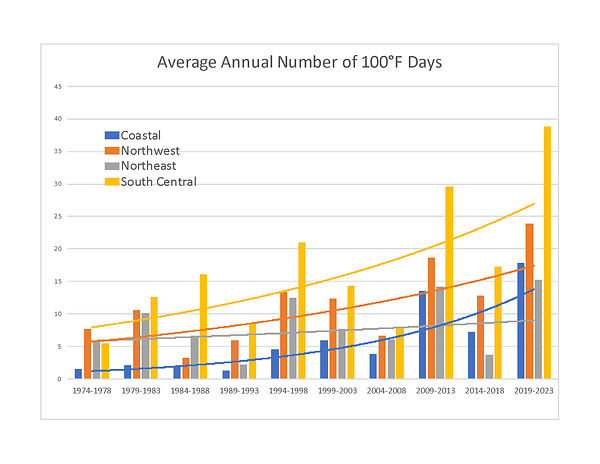Extreme heat remains on track to become Texas’ new normal
An update to the 2021 groundbreaking study on extreme weather trends in Texas finds that the extreme heat and drought recorded this summer fit into an accelerating trend toward hotter summers and milder winters in the Lone Star State.
In particular, hot summers in 2022 and 2023 moved sharply upward with the long-term trend toward an increase in the number of 100-degree days each summer, with the frequency of triple-digit days tripling over the past 40 years.
The study, originally published in 2020 and updated in October 2021, was conducted by the Texas State Climatologist, Texas A&M University, and Texas 2036. It will receive a new comprehensive update in early 2024.
Dr. John Nielsen-Gammon — a Regents Professor at Texas A&M who was named State Climatologist by then-Gov. George W. Bush in 2000 — led the team of A&M researchers, who analyzed decades of Texas weather records to project climate trends out to 2036, the year of Texas’ bicentennial.

“The number of triple-digit days was large in 2022 and even larger in 2023. As a result of this, the long-term trends in the number of triple-digit days are sharply upward,” Nielsen-Gammon said. “The 2021 update to the report noted that triple-digit days had doubled in frequency since the 1970s. As of now, the average number of triple-digit days has actually tripled.”
The report was funded by Texas 2036, a nonprofit, nonpartisan policy organization focused on ensuring Texas remains the best place to live and work.
Overall, the Texas A&M report shows that Texas’ weather pattern is trending toward worsening extremes. The study analyzed a variety of past and future meteorological trends, including average temperatures, extreme temperatures, precipitation, extreme rainfall, drought, river flooding, urban flooding, winter precipitation, severe thunderstorms, hurricanes and coastal erosion, and wildfires.
Here’s what the data says about our extreme weather trends:
- In almost all regions of the state, it’s now common to have at least 10 triple-digit days in a given year. In the 1970s and 1980s, this high number of triple-digit days was rare.
- In coastal regions, a summer with multiple triple-digit days has gone from rare to ordinary, and a typical station in south-central Texas can now expect to see multiple weeks’ worth of triple-digit days in the summertime.
- In 2023, the average summer hottest temperature came in at 106°F, surpassing the previous record set in 2011. The primary difference from 2011 was that 2023’s heat persisted through most of September, while 2011 had already turned somewhat milder by then.
- Milder winters are being offset by increasingly hot summers. The drought of 2023 fit this pattern, as the excess heat increased evaporation and allowed drought impacts to develop more rapidly.
Recent polling by Texas 2036 shows that Texans are also noticing changes in our weather patterns and the impact of extreme weather events on their pocketbooks.
Texas 2036 in its Texas Voter Poll released this summer found that 78% of Texas voters think Texas’ climate has changed over the past 10 years, with 41% of respondents saying those changes have been dramatic. And 87% of voters said they were concerned weather-related events in Texas such as wildfires, floods, drought, and hurricanes could increase what they pay for property insurance.
Taken together, the science and surveys suggest that Texas state policymakers should consider the impacts that extreme weather trends have on several critical policy areas, including water supply, flood control, and energy.
“The data confirms our previous finding that Texas’ weather patterns are becoming more extreme,” said Texas 2036 Senior Policy Advisor Jeremy Mazur. “This opens the door for policy discussions on what can be done to adapt to these changes or, where possible, mitigate their effects on Texas communities.”
State officials have begun incorporating climate data into long-term planning, such as legislation passed in the 2023 regular Texas legislative session to allow regional water planners to consider planning for worsening droughts. Lawmakers also adopted legislation that would update water availability models across several Texas river basins.
Texas can now further address key challenges and vulnerabilities in the state’s water systems after the approval of Proposition 6, which created the new Texas Water Fund — the first voter-approved constitutional amendment addressing the state’s water supply in 10 years.
This new fund, which passed with close to 78% approval, may be used for developing new water supplies, and for fixing aging, deteriorating water systems.
A complete update to the Assessment of Historic and Future Trends in Extreme Weather in Texas, 1900-2036 report is in progress and will be released in early 2024.
Read more here: https://texas2036.org/weather/
